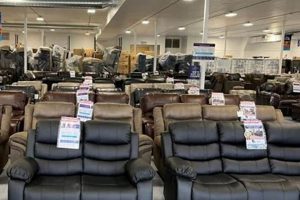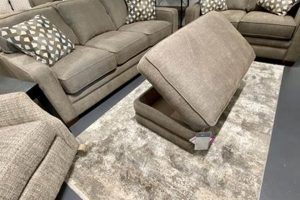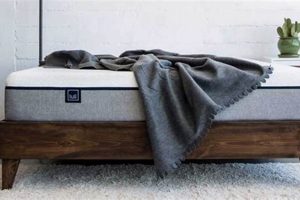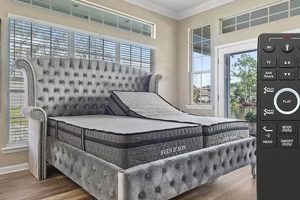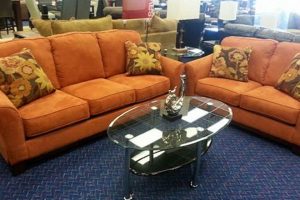Household furnishings and sleep surfaces representing common sizes, materials, and construction methodologies are foundational elements in residential and commercial spaces. These items, readily available and widely utilized, provide essential functionality for daily activities, from seating and storage to restful sleep.
The prevalence of widely accepted dimensions and manufacturing processes ensures affordability and ease of replacement. This contributes to the efficiency of housing markets and interior design projects. Historically, the establishment of these norms facilitated mass production and distribution, making comfortable living accessible to a broader population.
The following sections will delve into specific considerations for selecting these items, evaluating their durability, and understanding their impact on overall comfort and well-being within a given environment.
Guidance on Selecting Common Furnishings and Sleep Products
The following are practical considerations for the selection and maintenance of commonly available furnishings and sleep products. These guidelines aim to enhance longevity, ensure comfort, and maximize the value of these essential household items.
Tip 1: Prioritize Frame Construction: Examine the underlying framework for structural integrity. Solid wood or reinforced metal frames in seating and storage solutions provide greater stability and resistance to wear compared to particleboard alternatives.
Tip 2: Evaluate Material Durability: Consider the wear resistance of surface materials. Opt for fabrics with high rub counts for upholstery and select finishes on case goods that are scratch-resistant and easy to clean.
Tip 3: Assess Support Systems: When selecting a sleep surface, evaluate the internal coil or foam structure. A robust support system ensures proper spinal alignment and minimizes premature sagging.
Tip 4: Verify Dimensional Compatibility: Confirm that the chosen items are appropriately scaled for the intended space. Accurate measurements prevent overcrowding and facilitate efficient traffic flow within the room.
Tip 5: Understand Warranty Provisions: Review the manufacturer’s warranty for coverage details and duration. A comprehensive warranty offers protection against defects in materials and workmanship.
Tip 6: Inquire About Care Requirements: Familiarize yourself with recommended cleaning and maintenance procedures. Proper care prolongs the lifespan and maintains the aesthetic appeal of the purchased items.
Tip 7: Confirm Compatibility with Bedding: Verify the size of the sleep surface matches standard bedding dimensions. This will ensure ease of finding sheets, comforters, and other accessories.
Adherence to these guidelines will facilitate informed purchasing decisions and contribute to the long-term satisfaction with commonly used furnishings and sleep products.
The concluding section will consolidate key insights and reinforce the importance of making thoughtful selections when acquiring these fundamental elements of interior spaces.
1. Dimensions
The dimensional aspect of household furnishings and sleep surfaces dictates their functional integration within defined spaces and influences overall user experience. Adherence to widely accepted measurements is fundamental for optimizing space utilization and ensuring compatibility with related accessories.
- Room Layout Integration
Predefined sizes facilitate efficient room planning. Sofas, tables, and beds are designed to fit within common room dimensions, allowing for the creation of functional layouts. Departure from these norms can lead to spatial inefficiencies and hinder furniture placement.
- Mattress and Bed Frame Compatibility
Established mattress sizes (Twin, Full, Queen, King, California King) are directly correlated with corresponding bed frame dimensions. This standardization guarantees proper fit and prevents issues such as overhang or inadequate support. Deviation from these standard measurements necessitates custom-made solutions, incurring additional expense.
- Seating Height and Ergonomics
Standard seat heights for chairs and sofas are engineered to promote comfortable posture and ease of movement. These dimensions are based on average human anthropometric data, aiming to reduce strain on the back and legs. Variations in seat height can compromise ergonomic benefits and lead to discomfort.
- Storage Capacity and Accessibility
The internal dimensions of storage units, such as dressers and cabinets, determine their practical storage capacity. Standardized drawer and shelf depths allow for efficient organization and accessibility of stored items. Discrepancies in these measurements can limit storage potential and hinder usability.
In summary, dimensional conformity in household furnishings and sleep surfaces is paramount for spatial efficiency, ergonomic considerations, and seamless integration with related accessories. Deviation from these established measurements can introduce functional challenges and compromise user satisfaction. The adherence to standard dimensions is thus integral to the design and selection process.
2. Materials
The selection of constituent substances profoundly influences the performance, longevity, and aesthetic properties of common household furnishings and sleep surfaces. Material choices dictate durability, comfort, and overall value, making their careful consideration essential during the acquisition process.
- Frame Composition and Structural Integrity
Frame construction materials directly correlate with load-bearing capacity and resistance to deformation. Solid hardwoods, such as oak or maple, provide superior strength and stability in seating and case goods compared to engineered wood products like particleboard or medium-density fiberboard (MDF). Metal frames, often steel, offer exceptional durability and are commonly employed in bed frames and supportive furniture components. Inferior materials compromise structural integrity, leading to premature failure.
- Upholstery Fabrics and Surface Performance
The choice of upholstery fabric affects resistance to abrasion, staining, and fading. Natural fibers like cotton and linen offer breathability but may lack durability. Synthetic materials, such as polyester and microfiber, exhibit enhanced stain resistance and longevity, making them suitable for high-traffic areas. Leather, a premium upholstery option, provides exceptional durability and a luxurious aesthetic. The selection should align with anticipated usage patterns and desired maintenance levels.
- Sleep Surface Core and Comfort Layers
The core of a sleep surface determines its support characteristics and longevity. Innerspring mattresses utilize coils made of steel, with coil count and gauge influencing firmness and support. Foam mattresses employ various densities and types of polyurethane or memory foam, impacting pressure relief and temperature regulation. Latex mattresses offer a natural alternative with enhanced breathability and durability. The selection of core material depends on individual sleep preferences and desired levels of support and comfort.
- Finishes and Protective Coatings
Surface finishes and protective coatings enhance the aesthetic appeal and protect underlying materials from damage. Wood furniture often receives varnish, lacquer, or polyurethane coatings to resist scratches, moisture, and UV exposure. Metal components may undergo powder coating or plating processes to prevent corrosion. These finishes extend the lifespan of furnishings and maintain their appearance over time. Inadequate or absent finishes can accelerate deterioration and diminish value.
Therefore, mindful evaluation of constituent substances is paramount when procuring commonly available furnishings and sleep surfaces. Material selection directly impacts structural soundness, surface performance, comfort characteristics, and long-term durability, collectively influencing the overall value and satisfaction derived from these essential household items.
3. Construction
The structural integrity and longevity of furnishings and sleep surfaces are directly contingent upon their construction methods. The way in which materials are assembled and joined determines the capacity of a piece to withstand stress, resist wear, and maintain its form over extended periods. This is especially critical in standard items, where uniformity and predictable performance are expected.
For example, a sofa with a frame constructed using mortise-and-tenon joinery, reinforced with corner blocks and metal fasteners, exhibits superior stability compared to one relying solely on staples or adhesive. Similarly, a mattress featuring individually wrapped coils provides targeted support and minimizes motion transfer, in contrast to a traditional innerspring system with interconnected coils. The choice of stitching patterns and seam reinforcement in upholstered items directly influences their resistance to tearing and seam slippage. Mass produced items generally incorporate more cost-effective construction techniques with acceptable durability which are very common in the furniture & mattress sector.
In conclusion, understanding construction techniques is essential for evaluating the quality and durability of furnishings and sleep surfaces. Careful attention to joinery methods, support systems, and reinforcement details informs purchasing decisions, leading to greater long-term satisfaction and a reduced likelihood of premature failure. Thus, construction stands as a foundational element in the overall assessment of these everyday items.
4. Durability
The enduring utility of widely available household furnishings and sleep surfaces hinges directly on their capacity to withstand the stresses of regular use and environmental factors. The lifespan and overall value proposition are inextricably linked to their inherent resistance to degradation, deformation, and failure.
- Material Selection and Resistance to Wear
The intrinsic properties of constituent materials dictate their ability to resist abrasion, impact, and chemical degradation. For instance, hardwood frames in seating and storage solutions exhibit superior resistance to warping and cracking compared to composite wood alternatives. Similarly, high-density foam cores in sleep surfaces provide greater resistance to compression and sagging over time. Selecting materials with inherent resistance to wear is paramount for prolonging the functional lifespan of these items.
- Construction Methods and Structural Integrity
The techniques employed to assemble and reinforce components directly influence the structural integrity of furnishings and sleep surfaces. Dovetail joinery in case goods and reinforced coil systems in mattresses enhance their ability to withstand stress and maintain their form. Robust construction methods minimize the risk of joint failure, frame deformation, and premature degradation of internal support structures.
- Surface Finishes and Protection Against Environmental Factors
Protective coatings and surface treatments shield underlying materials from environmental stressors, such as moisture, UV radiation, and staining agents. Durable finishes, such as catalyzed varnishes on wood furniture and stain-resistant treatments on upholstery fabrics, mitigate the effects of exposure and prolong the aesthetic appeal and structural integrity of these items. Inadequate surface protection accelerates deterioration and diminishes long-term value.
- Maintenance Practices and Longevity
Regular cleaning and maintenance practices are essential for preserving the durability and extending the lifespan of furnishings and sleep surfaces. Periodic cleaning of upholstery fabrics prevents the accumulation of dirt and grime, which can abrade fibers and accelerate wear. Routine mattress rotation and flipping distribute wear evenly and prevent premature sagging. Adhering to recommended maintenance protocols safeguards against preventable damage and maximizes the return on investment.
In summation, the durability of common household furnishings and sleep surfaces is a multifaceted attribute influenced by material selection, construction methods, surface finishes, and maintenance practices. These interrelated factors collectively determine the capacity of these essential items to withstand the rigors of daily use and maintain their functional integrity over time. Prioritizing durability during the purchasing process ensures long-term satisfaction and reduces the need for frequent replacements.
5. Ergonomics
The design and construction of standard household furnishings and sleep surfaces directly impact user comfort, posture, and musculoskeletal health. Ergonomics, the science of designing products to optimize human well-being and overall system performance, is therefore a critical consideration in their development and selection. Ill-considered designs can lead to discomfort, pain, and potentially long-term health issues, underscoring the importance of ergonomic principles.
Standard seating, for instance, should provide adequate lumbar support to maintain the natural curvature of the spine and prevent back strain. Seat height and depth must accommodate a range of body sizes to ensure proper leg positioning and reduce pressure on the thighs. A sleep surface should provide adequate support to maintain spinal alignment during sleep, preventing pressure points and minimizing the risk of neck and back pain. Mattresses that are too firm or too soft can both contribute to discomfort and poor sleep quality. Ergonomic designs should be a core part of the manufacturing process, taking account of the physical well-being of the users.
Prioritizing ergonomic design in standard furnishings and sleep products promotes comfort, reduces the risk of musculoskeletal disorders, and contributes to overall well-being. Understanding these ergonomic principles enables informed purchasing decisions, ensuring that furniture and sleep surfaces are not only functional but also supportive of long-term health. As such, ergonomic features should be a key consideration when evaluating these essential household items.
6. Affordability
The economic accessibility of common household furnishings and sleep surfaces is a critical factor influencing consumer purchasing decisions and overall living standards. Affordability considerations directly impact the quality, quantity, and suitability of items acquired for residential and commercial environments.
- Material Sourcing and Production Costs
The selection of raw materials and manufacturing processes exerts a considerable influence on the final retail price. Mass production techniques, utilization of readily available materials (e.g., engineered wood products, synthetic fabrics), and streamlined supply chains contribute to reduced production expenses, making these items economically viable for a broader consumer base. Conversely, the use of premium materials (e.g., solid hardwoods, top-grain leather) and handcrafted construction methods inherently elevates production costs and consequently, the retail price point.
- Distribution Channels and Retail Markups
The pathway through which these items reach consumers impacts their final cost. Direct-to-consumer models, characterized by reduced overhead and the elimination of intermediary markups, often translate into lower retail prices. Conversely, traditional retail channels, involving multiple layers of distribution and associated operational expenses, typically result in higher consumer prices. The choice of distribution strategy is, therefore, a significant determinant of affordability.
- Design Simplification and Feature Reduction
The incorporation of elaborate design elements and advanced features (e.g., powered reclining mechanisms, integrated storage solutions) adds to the complexity and cost of manufacturing. Simplifying designs, reducing the number of moving parts, and minimizing ancillary features contribute to streamlined production processes and lower retail price points. Value-engineered designs prioritize essential functionality while minimizing extraneous embellishments to enhance affordability.
- Market Competition and Pricing Strategies
Competitive market dynamics play a crucial role in shaping pricing strategies and influencing overall affordability. Intense competition among manufacturers and retailers often leads to price wars and promotional offers aimed at capturing market share. These competitive pressures incentivize cost-cutting measures and efficiency improvements, ultimately benefiting consumers through lower prices and greater value for money.
In summary, the affordability of common household furnishings and sleep surfaces is a multifaceted consideration influenced by material sourcing, production methods, distribution channels, design complexities, and competitive market forces. Understanding these factors enables consumers to make informed purchasing decisions that align with their budgetary constraints and functional requirements. Therefore, the pursuit of affordable options necessitates a careful evaluation of trade-offs between price, quality, durability, and desired features.
7. Availability
The readily accessible nature of common household furnishings and sleep surfaces is a defining characteristic that significantly influences consumer choice and market dynamics. The widespread presence of these items across diverse retail channels ensures that basic furnishing needs can be met with relative ease, contributing to overall residential comfort and functionality.
- Mass Production and Distribution Networks
Standard dimensions and simplified designs facilitate mass production, enabling manufacturers to achieve economies of scale. This, in turn, supports extensive distribution networks that ensure product availability across a wide geographic area. The accessibility of these items is further enhanced by partnerships between manufacturers and large retailers, both online and brick-and-mortar.
- Retail Channel Diversity
These furnishings and sleep surfaces are offered through a variety of retail outlets, catering to different consumer preferences and budget levels. Options range from large furniture chains and department stores to online marketplaces and discount retailers. This diverse landscape increases accessibility by providing consumers with multiple avenues to acquire these essential items. Further diversity of availability are local owned furniture & mattress stores.
- Inventory Management and Quick Replacements
The standardization of designs and sizes simplifies inventory management for retailers. This allows for efficient restocking and ensures that commonly requested items are readily available. The ease of replacement is a significant advantage, particularly in situations where furniture needs arise unexpectedly or when damage necessitates immediate replacements. The quick replacement options and furniture choices help the standard furniture & mattress market running smoothly.
- Impact on Housing Markets
The ready availability of these standardized items contributes to the efficiency of housing markets. New homeowners or renters can quickly and affordably furnish their spaces, facilitating residential transitions. The consistent supply also supports the property management sector, enabling landlords to efficiently furnish rental units and maintain consistent standards across their properties.
In conclusion, the pervasive availability of standard furnishings and sleep surfaces is a key factor shaping consumer expectations and influencing the overall efficiency of related markets. The combination of mass production, diverse retail channels, and streamlined inventory management ensures that these essential items remain readily accessible, contributing to improved living standards and facilitating residential mobility. This helps availability of standard furniture & mattress improve overtime.
Frequently Asked Questions about Standard Furniture & Mattress
This section addresses common inquiries regarding commonly sized and constructed furniture pieces and sleep surfaces, providing clarity and dispelling misconceptions.
Question 1: What defines “standard” in furniture and mattress dimensions?
Standard dimensions refer to sizes widely accepted and manufactured across the industry. For mattresses, these include Twin, Full, Queen, King, and California King, each with established width and length measurements. Furniture adheres to generally recognized dimensions for seat height, table height, and storage unit depth, facilitating compatibility and space planning.
Question 2: How does standardization affect furniture pricing?
Standardization enables mass production, which generally lowers per-unit costs. Uniformity in design and size reduces manufacturing complexity, allowing for streamlined processes and economies of scale. This cost efficiency is often passed on to consumers in the form of more affordable prices.
Question 3: Are “standard” mattresses universally comfortable for all individuals?
While standard mattresses adhere to established size guidelines, comfort is subjective. Factors such as sleeping position, body weight, and personal preferences influence optimal mattress firmness and support. It is recommended to test different mattress types to determine individual comfort suitability, irrespective of standard sizing.
Question 4: What are the limitations of relying solely on “standard” sizes for furniture selection?
Relying solely on standard sizes may not accommodate unique spatial constraints or individual ergonomic requirements. Rooms with unusual dimensions or individuals with specific physical needs may require custom or non-standard furniture solutions to optimize functionality and comfort.
Question 5: How does the availability of standard furniture impact interior design flexibility?
The prevalence of standard sizes offers convenience and affordability but can limit design flexibility. Individuals seeking highly customized or unique aesthetics may find standard options restrictive and require bespoke furniture designs.
Question 6: What quality differences can be expected within the category of “standard” furniture?
Significant quality variations exist within the “standard” furniture category. Factors such as material quality, construction methods, and finishing techniques influence durability and longevity. Careful evaluation of these factors is essential to ensure the selection of high-quality items, even within the constraints of standard designs and sizes.
In summary, understanding the nuances of “standard” furniture and mattresses is essential for making informed purchasing decisions. While standardization offers benefits in terms of affordability and availability, it is crucial to consider individual needs and preferences to ensure optimal comfort, functionality, and design aesthetic.
The concluding section will provide actionable recommendations for maximizing the value and longevity of commonly sized furnishings and sleep products.
Standard Furniture & Mattress
The preceding exploration has illuminated the multifaceted nature of standard furniture & mattress options, emphasizing the interplay between dimensions, materials, construction, ergonomics, affordability, and availability. A thorough understanding of these elements is paramount for consumers seeking to make informed purchasing decisions that balance cost, quality, and personal preferences.
Moving forward, individuals should prioritize critical evaluation of construction quality and material durability to ensure long-term value. The informed selection and careful maintenance of standard furniture & mattress items are vital to maximizing utility, promoting well-being, and fostering comfortable living environments. The future of the sector hinges on continuous innovation and consumer awareness.


